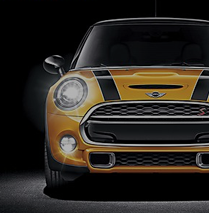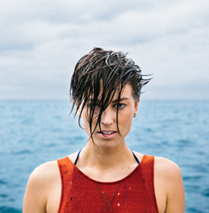How did you discover your passion for advertising and end up working together at GUT? “My passion started in college when I saw the careers of creatives I admired, like Gerry Graf,” says Miguel Cedeño. “And when I saw Gerry’s work, it fascinated me—and that inspired me to do similar things. I feel I’m not nearly close, but I’ll keep trying.”
“Looking at a print ad in an airplane magazine, I discovered I had a passion for ideas and creativity,” says Ricardo Chuecos. “I was still a kid and didn’t know that you could make a living thinking of creative ways to communicate and promote products, but I knew then that I wanted to be involved in that somehow.
“Now, being able to work together with Miguel at GUT is a whole other story,” Chuecos continues. “I didn’t go to a portfolio school. My family had recently migrated to the United States at the time, which meant money was tight and portfolio school was expensive. But I got a scholarship at a university and studied marketing there to get a degree closer to what I thought my parents would consider acceptable. From there, I started trying to get internships at agencies so that I could build my portfolio. It was a tough road, but Federico Hauri, an associate creative director at Saatchi Miami at that time, eventually gave me the opportunity that led me to my career in advertising. Afterwards, I did everything I could to get the attention of Ricardo Casal and Juan Javier Peña Plaza so that I could work with them. Eventually, they gave me a chance, and I got hired to work at GUT, where I met Miguel. Funnily enough, Ricky and Juan also had the idea to partner me with Miguel, which has been great ever since.”
What personal experiences or circumstances have most influenced your work or style, as individuals and as a team? “Overcoming introversion has been my biggest challenge, personally and work-wise,” says Cedeño. “In my first job, where I had to lead a team, I learned how to open up to others and to make small talk; being shy was no longer an option. I’m still introverted—except when reggaeton is on.”
“As an individual, having immigrated from another country has been the biggest influence on my work and everything I am,” Chuecos says. “I can borrow from different cultures when approaching each brief and find the best solution. As a team, we don’t think there is one single experience that has shaped our work. It’s actually the opposite: the collective of our experiences together allows us to find ways to build onto each other’s ideas in a way that resonates with what we’re trying to solve. Sometimes, all we do is talk about the work, and in that process, we find ideas. Other times, we force ourselves to talk about something else, and ideas would start flowing from there at some point.”
Tell us about the Super Bowl campaign with musical artist Lizzo for Google’s Pixel 6 phone with its new Real Tone camera technology. What was it like working on the campaign, and how did you develop your ideas for its execution? “Since we got the brief, we knew it would be an uncomfortable but necessary discussion,” Cedeño recalls. “We needed everyone to realize why lacking image equity is a challenge and, therefore, create a conversation and awareness around the importance of representation. It was a very collaborative and rewarding process.”
“We loved it from the get-go,” says Chuecos. “Google is on a mission to make images more equitable for all, and the Real Tone feature on the Pixel 6 was literally made for that. It was a very purpose-driven project, which, for us, is something we really value. We got to educate people about the fact that historically, cameras haven’t accurately portrayed darker skin tones and how the Pixel 6 is helping to solve that. We knew the tone of the spot and campaign was crucial for us to be able to deliver the message effectively, so we looked for someone who could help us humanize the technology while reinforcing how important it is for everyone to be truly seen. That’s why we thought Lizzo was perfect because of her authenticity, work and personality.”
“When we were thinking of a celebrity that aligned with the campaign’s tone, we all agreed it had to be Lizzo,” Cedeño explains. “It couldn’t be anyone else. The campaign was so powerful that the ideas came immediately. And having an unreleased song from her for the Super Bowl was the cherry on top.”
“When it came to developing executions for this idea, we always tried to ensure we could educate people about this problem, invite dialogue about image equity and celebrate all skin tones,” Chuecos says. “With that criteria in mind, it was easier to approach every execution beyond the spot and to keep the conversation going on social. Finally, it was rewarding to have worked on it. We closely monitored the conversation online and saw how people embraced the message. It was just beautiful to see.”
How was working on GUT’s first Super Bowl spot? “It was the first Super Bowl spot for both of us,” says Cedeño. “Working with a brand like Google was a remarkable learning experience. We were able to work on a campaign that helped build a more equitable space for everyone; you don’t always get those briefs on your desk. Although it is a common cliche, we always put our best into the work we have in front of us.”
“If someone had told us that when we started working at GUT, we would be part of its first Super Bowl spot for Google just one year later, we would have called that person delusional,” Chuecos admits. “It’s something that we will always cherish. We went the extra mile and learned as much as possible about the problem of image inequity so we could come at it with solid approaches and try to make everyone feel part of the conversation—and we got tons of help from Google in that area. They put us in touch with photographers, developers and users so that we could have informed opinions from all angles. We appreciated that because it helped us feel very confident when approaching the different asks of the brief.”
In our prior feature article on GUT, the agency’s cofounders Gastón Bigio and Anselmo Ramos introduced the concept of “reactvertising,” meaning campaigns that respond to current events and pop culture. How has it been working on campaigns that embody this concept, and how has it informed your ideas of what advertising can do? “It’s challenging and exciting,” Cedeño says. “Everyone at GUT must be ready to take advantage of all the opportunities that working with our brands have to offer at the speed of culture. So, anything can be an idea: a tweet, a meme or a TikTok. Fortunately, we have clients who react at the same pace—and that’s gold.”
“Reactvertising is one of those few opportunities where brands rely mainly on their gut feeling to interact with fans and get attention, and we simply love it,” Chuecos adds. “GUT is great at identifying real opportunities for our clients to be part of different cultural conversations, and we have learned a lot from our time here in doing them. It’s a skill that takes time to develop because you have to understand when it makes sense for the brand to participate and when it’s better to not react at all—and that’s different for every client. One of the main beauties of ‘reactvertising’ is that it gives agencies and brands the opportunity to draw from culture, come up with ideas and execute them fast. It’s a dialogue with the consumer, and when done correctly, it can reap amazing rewards.”
If you could choose any product to create an ad for, what would it be and why? “I always wanted to create a campaign for my local football team Barcelona de Ecuador,” says Cedeño. “I would also create ads for some of my childhood video games, including Grand Theft Auto and Mario Bros. These are things that I have treasured since I was a child.”
“It wouldn’t be an ad for a product but for an occasion: teacher appreciation week,” says Chuecos. “Professors, tutors and coaches play a huge role in our society. Along with parents, they raise entire generations, and I feel we’re not treating them with the respect they deserve. Creating a campaign to help lift them up would be very gratifying.”
What trends in advertising are you most interested in and why? “It’s not an advertising trend, but I’m always looking for interviews, podcasts and documentaries about other people’s lives—from regular to extraordinary individuals,” says Cedeño. “Getting into other people’s minds allows me to put myself in their shoes and gives me perspective. That’s helpful not only for advertising but for life as well.”
“I’m really into goodvertising,” says Chuecos. “We’re in a moment where brands can step in and help communities in places where government can’t due to lack of funds or priorities. You can create advertising that helps solve real-world problems while generating awareness, love and sales. I believe this type of work will become more and more prevalent as younger generations expect a certain level of responsibility from brands. There’s also something great about brands producing long-form content that goes beyond your usual advertising. It’s an exciting new field that lets brands connect more profoundly with their consumers. I have yet to have the opportunity to work on a long-form project, but I would definitely love to.”
What skills do young creatives need to succeed in advertising today? “Resilience, curiosity and the ability to act despite feeling fear,” says Chuecos.
“Having fun,” Cedeño says. “If you love what you do and have fun, you’re clearly on the right path.” ca












